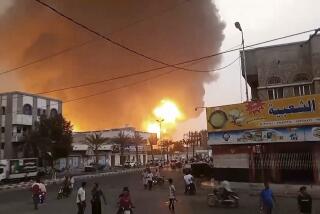U.S. airstrikes kill 5 suspected militants in Yemen
Reporting from Washington — U.S. military aircraft launched strikes that killed at least five suspected militants in southern Yemen in one of the deadliest attacks since the Pentagon and CIA stepped up counter-terrorist operations in the impoverished Middle Eastern nation last year, U.S. officials said.
The attacks Tuesday in Yemen’s Abyan province targeted a meeting of members of Al Qaeda in the Arabian Peninsula, a militant group whose leadership has been badly degraded in a series of U.S. air attacks, the officials said.
The aircraft fired missiles at a school where the suspected militants were meeting and at several vehicles, the officials said, with the main salvo coming from a fighter jet. News service reports estimated that a dozen people were killed in the attacks and another dozen wounded, but U.S. officials said they could not confirm those numbers.
The assault came hours after President Obama gave a vigorous defense of CIA drone attacks against Al Qaeda militants in Pakistan, publicly describing the program for the first time. He said such strikes were carefully targeted to avoid civilian casualties.
The CIA began flying drones in Yemen last year as part of a stepped-up campaign against what officials described as a growing threat from Al Qaeda in the Arabian Peninsula.
Tuesday’s attacks were carried out by aircraft under the control of the Joint Special Operations Command, which works closely with Yemeni security services in tracking militants.
Al Qaeda in the Arabian Peninsula has taken control of parts of Abyan, a mountainous area southeast of Yemen’s capital, Sana, and has beaten back attempts by the country’s security forces to oust it, U.S. officials said.
Security has collapsed in large parts of Yemen after an uprising against President Ali Abdullah Saleh, who arrived in the U.S. over the weekend for medical treatment.
Talhah al Yemeni, an Al Qaeda in the Arabian Peninsula leader, is believed to have been killed in Tuesday’s assault, a U.S official said.
U.S. officials denied reports that the attack was aimed at Abdul Munim Fathani, a Yemeni who was reportedly wanted in connection with the deadly strike in 2000 on the U.S. destroyer Cole in the Yemeni port of Aden. Reuters and other new organizations reported that Fathani had been killed, attributing the information to tribal leaders.
In September, Predator drones flown by the CIA killed radical Muslim cleric Anwar Awlaki, a U.S. citizen living in Yemen, and another American who produced virulent propaganda for Al Qaeda.
A U.S. air attack in October killed nine other members of Al Qaeda in the Arabian Peninsula, also known as AQAP, near the town of Azzan in southeastern Yemen, including Awlaki’s 21-year-old son, Abdul-Rahman Awlaki, and Egyptian-born Ibrahim Banna, whom officials said was in charge of media for the group. .
In testimony to Congress on Tuesday, Director of National Intelligence James R. Clapper said, “We judge [that] AQAP remains the node most likely to attempt transnational attacks. [Anwar Awlaki’s] death probably reduces, at least temporarily, AQAP’s ability to plan transnational attacks, but many of those responsible for implementing plots, including bomb makers, financiers and facilitators, remain and could advance plots.”
More to Read
Sign up for Essential California
The most important California stories and recommendations in your inbox every morning.
You may occasionally receive promotional content from the Los Angeles Times.










